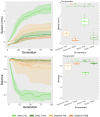Environmental influences on evolvable robots
- PMID: 32470076
- PMCID: PMC7259730
- DOI: 10.1371/journal.pone.0233848
Environmental influences on evolvable robots
Abstract
The field of Evolutionary Robotics addresses the challenge of automatically designing robotic systems. Furthermore, the field can also support biological investigations related to evolution. In this paper, we evolve (simulated) modular robots under diverse environmental conditions and analyze the influences that these conditions have on the evolved morphologies, controllers, and behavior. To this end, we introduce a set of morphological, controller, and behavioral descriptors that together span a multi-dimensional trait space. Using these descriptors, we demonstrate how changes in environmental conditions induce different levels of differentiation in this trait space. Our main goal is to gain deeper insights into the effect of the environment on a robotic evolutionary process.
Conflict of interest statement
The authors have declared that no competing interests exist.
Figures















References
-
- Eiben AE, Smith JE. Introduction to Evolutionary Computing. 2nd ed Springer; 2015.
-
- Howard D, Eiben AE, Kennedy DF, Mouret JB, Valencia P, Winkler D. Evolving embodied intelligence from materials to machines. Nature Machine Intelligence. 2019;1(1):12–19. 10.1038/s42256-018-0009-9 - DOI
-
- Vargas PA, Paolo EAD, Harvey I, Husbands P, editors. The Horizons of Evolutionary Robotics. MIT Press; 2014.
-
- Darwin C. On the origin of species, 1859. Routledge; 2004.
MeSH terms
LinkOut - more resources
Full Text Sources

